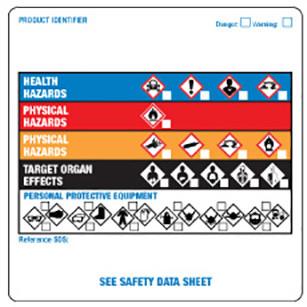As entrepreneurs commercialize “nanomaterials”, occupational safety and health (OSH) agencies and professionals are developing standards to evaluate and manage the associated hazards. These protective efforts cover the full range of OSH agency efforts. The easiest step is to expand application of the Employer’s General Duty to protect workers against workplace hazards to cover nanomaterials –easiest since this Clause requires employers to take steps against “recognized” hazards, and do not bind the agencies to promulgate specific standards (I’ve written about the General Duty Clause here, and about recommendations for comprehensive safety and health programs here). At the other extreme, the Occupational Safety and Health Administration (OSHA) or other OSH agencies can issue enforceable OSH standards –so far there are none exclusively addressed to nanomaterials, although some materials do trigger some standards (see below). Between these extremes, agencies can and do offer non-mandatory but detailed guidelines for some hazards – the National Institute for Occupational Safety and Health (NIOSH) just issued such a guide for nanomaterials, building on similar publications by other agencies. The rest of this blog discusses the new NIOSH guide, “Building a Safety Program to Protect the Nanotechnology Workforce: A Guide for Small to Medium-Sized Enterprises” (NIOSH Guide), and references some of resources used to produce them.
Read MoreAudit, Compliance and Risk Blog
Tags: Employer Best Practices, Health & Safety, OSHA, Employee Rights, EPA
On October 18, the Occupational Safety and Health Administration (OSHA) issued “Recommended Practices for Safety and Health Programs” (Recommendations) – which revises its 1989 “Safety and Health Program Management Guidelines” (S&H Guidelines). As the name indicates, these recommendations suggest activities employers should undertake to ensure their employees’ safety and health. They are not regulations or other requirements, but the 1989 Guidelines have long been used by agency inspectors and onsite S&H personnel as generally applicable roadmaps to safer workplaces. This month’s revision end a review process that included a proposal and request for comments published in November 2015 (I blogged about the proposal here).
Read MoreTags: Employer Best Practices, Health & Safety, OSHA, Employee Rights
OSHA Proposes Technical Changes To Dozens Of Requirements
Posted by Jon Elliott on Tue, Nov 08, 2016
The Occupational Safety and Health Administration (OSHA) has proposed to update and/or clarify dozens of provisions in its regulatory standards, within its General Industry, Construction, and Shipbuilding Standards, as the latest round in an ongoing “Standards Improvement Project.” The proposals were published in the October 4 edition of the Federal Register, and comments are due by December 5. Depending on the comments (and perhaps on the outcome of the Presidential election), OSHA plans to finalize changes early in 2017.
Read MoreTags: Employer Best Practices, Health & Safety, OSHA, Employee Rights
New Rules For Labor Law Compliance By Federal Contractors
Posted by Jon Elliott on Thu, Sep 22, 2016
In July 2014, President Obama issued Executive Order (EO) Number 13673, establishing a series of reporting and procedural requirements for federal contractors, inducing them to provide “Fair Pay and Safe Workplaces” to their employees. Some requirements are specific in the EO, while others were left for clarification by revisions to the Federal Acquisition Regulation (FAR), for contracts subject to these requirements. (I blogged about the EO here). None became effective in 2014, but instead they have awaited the FAR revisions. The revised FAR has been issued effective October 25, 2016, for appropriate contracts issued by the Department of Defense (DoD), General Services Administration (GSA) and National Aeronautics and Space Administration (NASA). The new requirements will be phased in, covering contracts and subcontracts for goods and services greater than $50 million immediately, and those greater than $500,000 effective April 25, 2017.
Read MoreTags: Employer Best Practices, OSHA, Employee Rights, EEOC, directors & officers
Applying A Hierarchy of Controls to Increase Workplace Safety
Posted by Jon Elliott on Tue, Jun 28, 2016
Every workplace poses at least some potential hazards to workers, but every set of hazards is unique. To effectively identify and manage those hazards, an organization should apply logical and systematic approaches. A number of related approaches are available. A few months ago I blogged about a proposal by the Occupational Safety and Health Administration (OSHA) to revise the Safety and Health Program Management Guidelines it promulgated back in 1989 (click here) – comments were due in February and OSHA is considering what to do next. OSHA’s proposal focused on overall program design, so included important structural considerations – who’s in charge, how are expectations communicated, etc.
Read MoreTags: Employer Best Practices, Health & Safety, OSHA, Employee Rights, EHS
OSHA Requiring Employers to Submit Injury and Illness information
Posted by Jon Elliott on Tue, Jun 14, 2016
The Occupational Safety and Health Administration (OSHA) requires most employers to prepare and maintain records of occupational injuries and illnesses as they occur (I&I Logs). OSHA also requires employers to post an annual I&I Summary in each “establishment” within their workplaces by February 1, summarizing that workplace’s I&Is during the previous calendar year. Delegated state-run programs impose comparable requirements. (I summarized these requirements here). Most of this information remains with employers and their employees, so it never gets used for analyses of workplace trends or to help OSHA evaluate areas where additional regulations might be most helpful.
Tags: Employer Best Practices, Health & Safety, OSHA, Employee Rights
Most of the laws and regulations discussed in these blogs exist to ensure proper management of hazardous chemicals and products, in ways designed to minimize environmental and human exposures. Pesticide management provides important variations on these themes, since pesticides are used for the very purpose of killing targeted organisms in the environment … and are regulated to target those uses to protect humans and other non-target species. Within the United States, the Federal Insecticide, Fungicide and Rodenticide Act (FIFRA) provides the national framework for regulation of pesticides, including registration of active ingredients and mixtures, licensing of applicators, and requirements for the application and use of these hazardous materials. FIFRA provides the U.S. Environmental Protection Agency (EPA) with overall responsibility, although different elements of pesticide regulation are subject to different balances of federal (EPA) and state control.
Read MoreTags: Health & Safety, OSHA, EHS, EPA, Hazcom
The Occupational Safety and Health Administration (OSHA) requires employers to protect their employees against possible exposure to “bloodborne pathogens (BBPs).” OSHA’s Bloodborne Pathogen Standard prescribes protections for workers occupationally exposed to blood or other potentially infectious materials (OPIM). Healthcare workers are the most obvious beneficiaries, but emergency responders and others may also be regularly at risk to these exposures.
Read MoreTags: Employer Best Practices, Health & Safety, OSHA, Employee Rights, Environmental risks, EHS, Hazcom, pharmaceuticals
The US Occupational Safety and Health Administration (OSHA) regulates thousands of chemicals, through regulatory standards directing employers to reduce worker exposures. At the broadest level, employers must evaluate basic information about every potentially hazardous chemical, and provide information to employees in compliance with OSHA's Hazard Communication Standard (I’ve blogged about changing HCS requirements here, and here). OSHA’s Air Contaminants Standard provides ambient workplace air limits for hundreds of listed contaminants. OSHA also provides more tailored requirements for classes of chemicals (such as flammables), and for types of activities that pose chemical hazards (such as welding). For a small number of especially hazardous chemicals, OSHA provides a detailed standard applicable to a single chemical—examples include asbestos, benzene, and lead. On March 25, 2016, OSHA established another single-chemical standard, for respirable crystalline silica (29 CFR section 1910.1053). Most affected employers must comply by June 23, 2018; a few provisions are phased in later, and construction employers must meet most requirements by June 23, 2017.
Read MoreTags: Health & Safety, OSHA, EHS, Hazcom
Even if your organization is not required to do so, you should consider the benefits or being prepared to conduct emergency responses and evacuations. Well-developed emergency plans and proper employee training (so employees understand their roles and responsibilities) likely will result in fewer and less severe employee injuries and less structural damage to the facility during emergencies. A poorly prepared plan, on the other hand, likely will lead to a disorganized evacuation or emergency response, exacerbating confusion, injury, and property damage.
Which Employers Require An EAP?
The following OSHA Standards require you to prepare an EAP as part of your compliance with their requirements:
Read MoreTags: Employer Best Practices, Health & Safety, OSHA, EHS, EPA, Hazcom, PSMS, EAP










